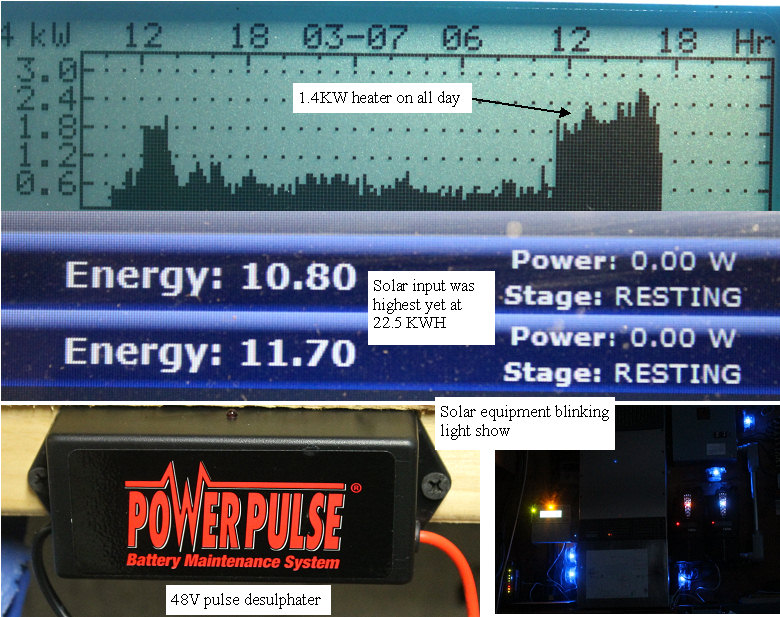Beating on the system/ use it or loose it
|
 | |
|
making it all work harder
|
Today was a nice day, and the batteries made it all night for the first time, so I decided to test the system by pushing it a bit. I set up a 1.5KW electric heater, and let it heat the solar/battery room all day. Unfortunately I forgot to turn off the heater and the batteries started discharging before I turned the heater off, the batteries were not fully charged, so I will not make it all night tonight.
The room and equipment got up to over 90F
The fans were running, but the internal temps all stayed in a comfortable zone.
The inverter is 8KW, and we were only at 2.5, so things better be ok.
The more precise hydrometer readings have confirmed that the batteries are in fact looking sulphated, so I got a High frequency pulse desulphater rated for 48V, and connected it.Should begin to see the capacity and specific gravity's improving if the thing really works.
It runs on the 48V, so it does not need a power cord.
Will have to put a scope on the batteries to see what the pulsing looks like.
The final task of connecting the big loads is next.
The issue here is that while the inverter can easily handle any of the big loads alone, it would have issues if two or more turned on at the same time. It is also important to only use the big loads when the sun is out, and the panels can supply most of the energy, as my rather small battery bank at this time of year can not even make it all night.
As the days get longer, and the nights get shorter,and I reduce my night time loads. I will reach a point where the batteries and solar get me 24 hours of off grid.
I am thinking that powering the big loads each with a big solid state relay, would let me design a big load management computer.
The energy sinks for the excess production would be the Air compressor, Hot water heater, electric heat pump, and finally the electric hot air furnace.
The on demand loads would be the electric range,machine shop , welding equipment which should be able to run whenever it is turned on, which means I will need to make sure to use the shop equipment one load at a time.
The load management system would need to know when an appliance is turned on, and then the actual application of power would be processed by the management computer, which would turn on the solid state relay and the load.
Each load would be assigned a priority. and when none of the on demand loads are on, the excess energy would make hot water, compressed air, or electric heat.
At night, the big loads would be turned off, and the energy stored as compressed air, hot water, or energy stored in the house as heat would carry until the next day, so the batteries will last all night. The highest priority will be to recharge the batteries, then when the charge controller goes into float, and turns on the Aux relay to divert the excess energy where it does the most good.
The fun is just beginning.
|
|